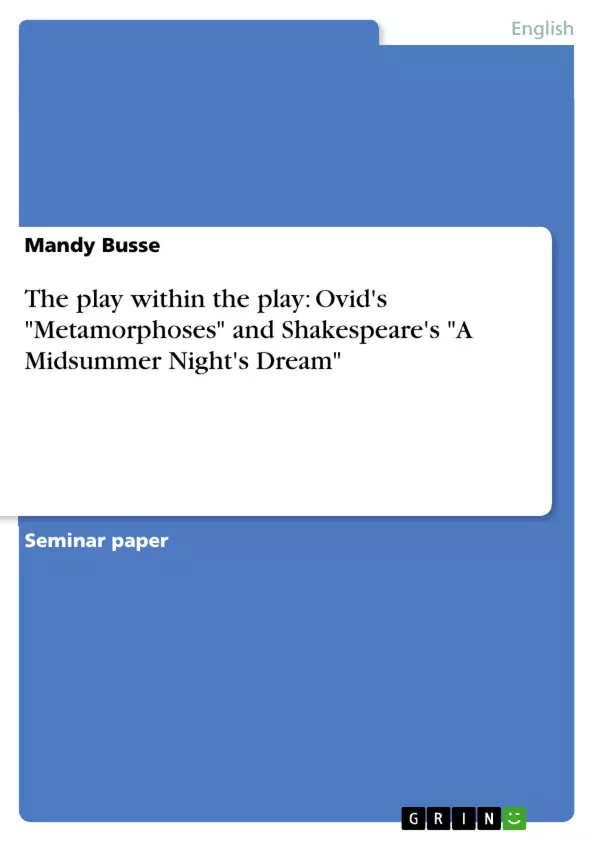“[By Reading Ovid’s Metamorphoses, the Elizabethans could](…) dig beneath its layers of fiction in an effort to recover the most precious secrets of the ancient world, whether moral, philosophical, historical, or scientific.”
It is beyond all doubt, that the great poetry of Ovid (43 BC – 17 AD) had a strong influence on William Shakespeare’s work. Understandably enough, as Ovid’s work is a classical masterpiece of Latin literature. It fascinates with its formal perfection, urban humour and Ovid’s creative fantasy. His outstanding opus is of course the Metamorphoses, the magnificent epic poem containing about 250 transformation legends of Greek and Roman mythology. Ovid’s interests in myths show also the heroides, which include fictitious love letters. Love – this is undoubtedly a central theme in Ovid’s literature. His writings Amores, Ars amatoria and Remedia amoris display that. Although Ovid’s literature was banished from public libraries by emperor Augustus after the poet’s death, his posthumous fame could not be prevented – fortunately. Ovid’s work had a great influence on medieval literature and during renaissance his mythological stories had been example for many novellas .
The role of Ovid’s greatest opus, the Metamorphoses in Shakespeare’s work, especially in his comedy A Midsummer Night’s Dream, is going to be discussed in this paper. At first the focus lies on Ovidian literature in Elizabethan times. Then, the parody of Pyramus and Thisbe in A Midsummer Night’s Dream will be analysed. A special kind of metamorphosis – the one of Bottom brings up the third main emphasis.
By the way – what is a metamorphosis? It is said to be a process in which somebody or something changes completely into something different – for example a caterpillar that becomes a beautiful butterfly…
Inhaltsverzeichnis (Table of Contents)
- Introduction
- The Shakespearian Ovid
- Pyramus & Thisbe in A Midsummer Night's Dream
- Conclusion
Zielsetzung und Themenschwerpunkte (Objectives and Key Themes)
This paper examines the influence of Ovid's Metamorphoses on Shakespeare's A Midsummer Night's Dream. The paper first explores the significance of Ovidian literature in Elizabethan times, followed by an analysis of the parody of Pyramus and Thisbe in Shakespeare's play. Finally, it discusses the theme of metamorphosis, specifically focusing on Bottom's transformation in the play.
- The influence of Ovid's Metamorphoses on Elizabethan literature
- The parody of Pyramus and Thisbe in A Midsummer Night's Dream
- The theme of metamorphosis in Shakespeare's play
- The relationship between Ovid's classical mythology and Shakespeare's dramatic themes
- The role of humor and satire in Shakespeare's adaptation of classical mythology
Zusammenfassung der Kapitel (Chapter Summaries)
The Introduction chapter explores the enduring influence of Ovid's Metamorphoses on Elizabethan literature, highlighting the significance of Ovid's work as a source of inspiration for Shakespeare and other writers of the era.
The second chapter, "The Shakespearian Ovid," delves into the ways in which Shakespeare incorporated Ovidian themes and characters into his own works. It examines the specific influence of the Metamorphoses on Shakespeare's early and later works, emphasizing the importance of Ovid's themes of love, tragedy, and transformation in Shakespeare's writing.
The third chapter, "Pyramus & Thisbe in A Midsummer Night's Dream," focuses on the play within the play, analyzing Shakespeare's adaptation of the tragic love story of Pyramus and Thisbe. The chapter discusses the comical aspects of Shakespeare's version of the myth, examining the role of the "rude mechanicals" in the performance.
Schlüsselwörter (Keywords)
This paper explores the intersection of classical mythology, Shakespearean comedy, and the theme of metamorphosis. Key concepts include Ovid's Metamorphoses, Elizabethan literature, Shakespearean adaptation, Pyramus and Thisbe, parody, and transformation.
- Quote paper
- Mandy Busse (Author), 2006, The play within the play: Ovid's "Metamorphoses" and Shakespeare's "A Midsummer Night's Dream", Munich, GRIN Verlag, https://www.hausarbeiten.de/document/75890


